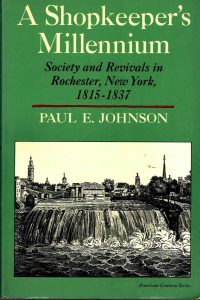A Shopkeeper’s Millennium Summary
Paul E. Johnson, the author of A Shopkeeper’s Millennium, inthe book, Johnson looks at the society of Rochester at a whole and how it was affected from the revivals from 1815 through 1837. Johnson takes a look at certain documents from the city of Rochester as well as church records, politics, society, and the economy.
 He explains the significance of the revivals and why they took place throughout the text. Johnson feels that the revivals had little to do with family breakdowns, and isolations. In the book Johnson shows the relationship between Rochester citizens and the city’s new industrial expansion during the first and second great awakening.
He explains the significance of the revivals and why they took place throughout the text. Johnson feels that the revivals had little to do with family breakdowns, and isolations. In the book Johnson shows the relationship between Rochester citizens and the city’s new industrial expansion during the first and second great awakening.
In the first chapter Johnson tries to create an understanding of the economy during that time period. He described the current economic situation of that time period well enough to be understood by the reader. In the beginning of this chapter he talks about Finney, and then throughout that chapter he fades away and goes to an earlier time period. He’ll then bring Finney back up later in the chapter. Johnson will talk about Finney and his impact on the revivals. The next three chapters in the book talked about the society, politics, and impasse of Rochester.
Order custom essay A Shopkeeper’s Millennium Summary with free plagiarism report
 450+ experts on 30 subjects
450+ experts on 30 subjects
 Starting from 3 hours delivery
Starting from 3 hours delivery
In the chapter about Society, Johnson outlines the merchant’s household and how it formed the basis for the old elite’s point of view of society. For example, the merchants had their workers live with them and the workers were basically a part of the merchant’s family. At that time most of the work was done in the merchant’s house. But when Finney arrived, the working man left the homes of their employers and the merchants started to become capitalists.
They separated themselves both in a social status way, and by their habitats. On page 48 Johnson notes that through the 1820s the workers were living in neighborhoods away from their employers. Another major topic in the section about society, Johnson talks about the drinking problem of the late 1820s came directly from the new relationship between master and the wage earner. In chapter three: Politics, Johnson discusses the division that was divided by the masonry and lower classes. He describes how the village government was able to arrest drunkards, gamblers, and how they had the ability to shut down theaters, circuses, and shops. During the years of 1827 and 1828 politicians were divided and voters made it clear that they did not want to be reformed by force.
The next chapters of the book all had very descriptive details about Charles Finney and how he was a major player in revivals in Rochester. In the book, Johnson states; the men who were attending Charles Finney’s church, were all far more successful and at a higher rank than most. Johnson describes the layout of the Rochester revival. The main theme that seemed to pop up in chapter 4 was the drinking problem in the society. Also some of the upper class people recognized their ability to control the working man through moral authority. For example, in 1828 Lyman Beecher formed a temperance in the Rochester society that would try and make men ashamed of drinking. Chapter 6, Johnson talks about how the Whig party got started through the revival manifest. During this revival, there was a movement to abolish pew rents, as well as funding of working class churches.
As I read through this book there were a lot of things that I didn’t like and thought could be changed. Throughout the book Johnson is strictly focused on the male role in Rochester. Hebarley mentions the great role that women played in the households of the houses during the revivals. Another thing that I thought was it was confusing the way that he jumped back and forth throughout dates in the book. It had no foundation and was hard to focus due to the back and forth between dates. Also, I thought that some language he used could’ve been different and less confusing. But In conclusion, I thought that it was a good book despite those few problems that made the book hard to read at times.
Cite this Page
A Shopkeeper’s Millennium Summary. (2017, May 10). Retrieved from https://phdessay.com/a-shopkeepers-millennium/
Run a free check or have your essay done for you


